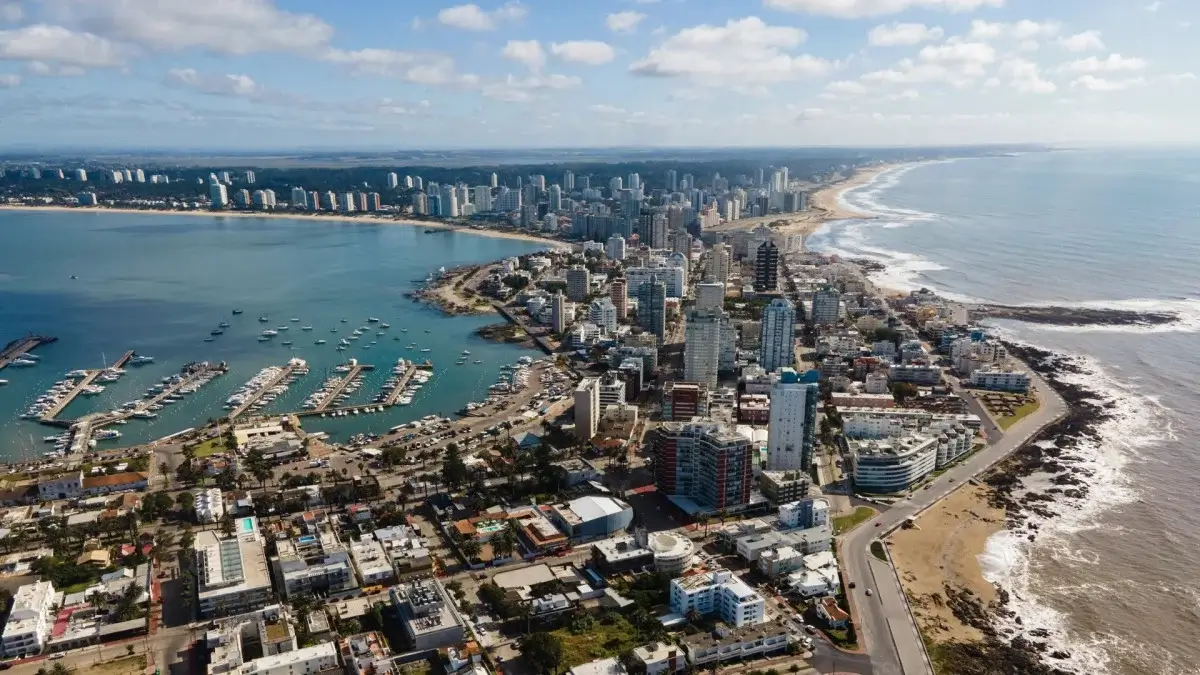Uruguay
Uruguay Country Guide

Uruguay is a small yet significant country located on the southeastern coast of South America. Brazil borders it to the north, Argentina to the west, and the Atlantic Ocean to the southeast. Uruguay is the second smallest country on the continent. Uruguay combines a rich historical background with a commitment to social progress and a stable economy, making it a unique and appealing destination in South America.
Things To Know Before Traveling To Uruguay
- Convert your local currency to US dollars before traveling.
- English is not widely spoken in Uruguay
- October through March are considered the best months.
- January is the busiest and most expensive month.
- Uruguay is considered one of the safest countries in South America.
- Dinner is served very late, usually at least 9 pm.
- There are no trains in Uruguay.
Is Uruguay Expensive To Visit?
Uruguay is an expensive destination for travelers, especially compared to other South American countries. Uruguay's cost of living index score is 61 points, which is more expensive than many European countries, including Italy and Sweden. In the context of global rankings, Uruguay's cost of living index is 65th in the world, with a score of 46.66 compared to New York City, which is the baseline at 100.
Is Going To Uruguay Worth It?
Yes, visiting Uruguay is worth it for several reasons:
- It is a more authentic and less crowded destination.
- It can still be visited on a budget.
- Uruguay offers a diverse range of attractions for its small size.
- Uruguay is considered one of the most socially progressive countries in Latin America.
Is Uruguay Good For A Honeymoon?
Yes, Uruguay is an excellent choice for a honeymoon, offering a blend of romance, relaxation, and unique experiences. Uruguay is known for its laid-back vibe, making it an ideal setting for couples seeking a relaxed and intimate getaway. The charming towns, stunning beaches, and picturesque landscapes create a romantic backdrop for honeymooners.
Is Uruguay Safe For Tourists?
Uruguay is generally considered safe for tourists and is often regarded as the safest country in Latin America. It ranks highly on the Global Peace Index, being the most peaceful country in the region and 35th globally.
Are Uruguay People Friendly?
Yes, Uruguayans are generally known for being friendly and welcoming. They are known for their relaxed vibe and openness to newcomers.
Best Cities In Uruguay
Here is a table with the best cities to visit in Uruguay:
| City Name | Best For | Best Attractions | Average Trip Cost |
|---|---|---|---|
| Montevideo | Culture, Art, Nightlife | - Ciudad Vieja (Old City) - Rambla waterfront promenade - Mercado del Puerto market - Palacio Salvo | $50-100 USD per day |
| Colonia del Sacramento | History, Architecture | - Barrio Histórico (Historic Quarter) - Plaza Mayor - Colonia del Sacramento Lighthouse | $40-80 USD per day |
| Punta del Este | Beaches, Luxury | - Playa Brava - Punta del Este Peninsula - Isla de Lobos (Sea Lion Island) | $80-150 USD per day |
| Piriápolis | Family-Friendly, Nature | - Cerro San Antonio - Playa de los Conventillos - Parque Salus | $30-60 USD per day |
| Salto | Thermal Springs, Wellness | - Daymán Thermal Springs - Arapey Thermal Springs - Salto Grande Dam | $40-80 USD per day |
| Rocha | Ecotourism, Beaches | - Cabo Polonio - Parque Nacional Santa Teresa - Laguna de Rocha | $30-60 USD per day |
Top Uruguay Attractions
- Rambla of Montevideo: This is the longest continuous sidewalk in the world, stretching over 22 km along the coastline. It is perfect for walking, jogging, or cycling.
- Plaza Independencia: The most important square in the capital, featuring a statue of General Artigas and his mausoleum beneath it.
- Mercado del Puerto: A bustling market is known for its excellent selection of local cuisine, particularly grilled meats.
- Museo Nacional de Artes Visuales: Home to Uruguay's most extensive visual arts collection, showcasing works by prominent artists.
- Barrio Histórico: A UNESCO World Heritage site, this historic quarter features cobblestone streets and colonial architecture, including the iconic lighthouse.
- Centro Cultural Bastión del Carmen: A cultural center that hosts art exhibitions and performances near the old port.
- Playa Brava and Playa Mansa: These two beaches offer different experiences; Playa Brava is known for its waves and the famous "Hand in the Sand" sculpture, while Playa Mansa is calmer and ideal for families.
- Casapueblo: An iconic building and art gallery created by Uruguayan artist Carlos Páez Vilaró, offering stunning ocean views.
- Hot Springs in Salto and Paysandú: Known for their therapeutic properties, they are perfect for relaxation.
- Cabo Polonio: A remote village known for its beautiful beaches and sea lion colonies, accessible only by 4x4 vehicles.
- Salto del Penitente: A picturesque waterfall in a rocky landscape offers hiking and rock climbing opportunities.
- Carnival in Montevideo: Experience the vibrant culture of Uruguay through its famous Carnival, featuring parades, music, and traditional dances like Candombe.
- Gaucho Culture: Explore the traditions of the gauchos, Uruguay's skilled horse riders, through various cultural events and ranch visits.
The Best Time To Visit Uruguay?
The best time to visit Uruguay is during its summer months, from December to March, particularly if you want to enjoy the beaches and coastal areas.
- Spring (September to November) offers mild weather that is perfect for exploring Montevideo and Colonia del Sacramento.
- Autumn (March to June) brings thinner crowds to the beaches and pleasant temperatures for outdoor activities.
- Winter (June to September), while cooler, is still comfortable for visiting cities and spotting whales off the coast.
Where Is Uruguay?
Uruguay is located in the southeastern part of South America. Brazil borders it to the north and northeast, Argentina to the west and southwest, and the Atlantic Ocean to the southeast.
What Is The Capital Of Uruguay?
Montevideo is Uruguay's capital and largest city, and it is a political, cultural, and economic center. It is located on the southern coast, along the northeastern bank of the Rio de la Plata estuary, and is home to nearly half of the country’s population.
Languages Spoken In Uruguay
Spanish is the official and most widely spoken language in Uruguay. Portuguese is the second most spoken language in Uruguay, especially in the border regions with Brazil. Some speak English in the business world, but it is limited to the general population.
Time Zone Of Uruguay
Uruguay is in the Uruguay Standard Time (UYT) zone, UTC-3. The country does not observe Daylight Saving Time, so the time remains consistent throughout the year.
Currency Of Uruguay
The currency of Uruguay is the Uruguayan peso, abbreviated as UYU.
Flag Of Uruguay
The Uruguayan flag features nine horizontal stripes alternating between white and blue and a white canton in the upper hoist-side corner containing the Sun of May.
- Stripes: The nine stripes represent the nine original departments of Uruguay.
- Canton: The white canton showcases the Sun of May, a symbol of the May Revolution of 1810 and the independence movements in South America.
Population Of Uruguay
Uruguay has a population of approximately 3.4 million. Most of the population resides in urban areas, particularly in the capital city, Montevideo, which houses nearly half the country's inhabitants.

